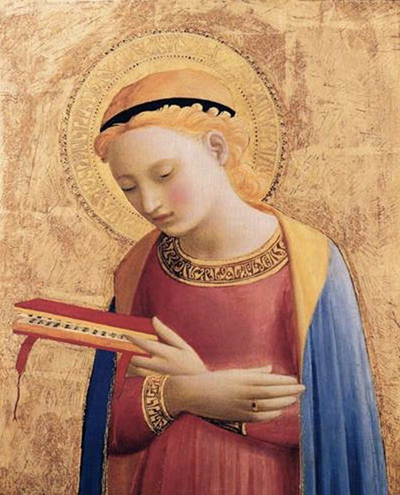Annunciate is a re-enaction of the biblical story of Archangel Gabriel revealing to the Virgin Mary that she was to carry the baby Jesus in her womb. It depicts Mary bowing down in submission to God's plan for her. The painting was part of an altarpiece in a monastery. It is a small painting measuring 13 x 10.63 inches.
The Annunciation is a popular theme in Christian art due to the centrality of its message to the faith. Frescoes depicting the scene date back to the 4th century. However, religious paintings became popular with mainstream artists during the middle ages and the Renaissance. Fra Angelico lived at a time when most Italian painters were fond of creating Annunciation artworks for altarpiece projects. Several Renaissance painters did works along the same theme, mostly in monasteries and churches. For instance, Lorenzo Lotto did a Venetian version of the virgin depicting Mary blushing in awe and apprehension after meeting the angel.
Fra Angelico was fond of annunciation paintings and did another piece called Annunciatory Angel. The style is strikingly similar in the use of light colors and sculptural forms to depict the archangel. Fra Angelico took inspiration from the works of Tommaso Masaccio and Giotto. For instance, the use of the sculptural style in depicting biblical figures is borrowed from Masaccio. Meanwhile, his emphasis on the use of art to promote ethical values was consistent with the philosophies of Giotto. Giotto's Expulsion From the Garden of Eden focuses on the sense of loss and humiliation rather than the theological perspective. Fra Angelico uses the same approach in The Annunciation fresco (1433), by depicting Mary from a human perspective.
Fra was an early Renaissance artist. Unlike Medieval painters, Renaissance painters were very methodical in their use of space and creating perspectives. They employed mathematical concepts such as geometry to render symmetry to their compositions. The figures were much more natural than gothic depictions with a realistic draping of clothing and spatial awareness. The follower who best epitomized his style was Benozzo Gozzoli. Just like Fra, Gozzoli added elaborate details to his paintings and went great lengths to produce a realistic depiction of the subject. Indeed, his work in Recanati Annunciation seems to be reenacting religious dramas in the same way Fra did with The Deposition of Christ. Since its production, the artwork has changed hands several times. It was part of the private collection of the Edsek Ford family until 1977 when they donated it to the Detroit Institute of Arts.
Medium: gold leaf and tempera on wood panel
Date of Production: 1433
Artist: Fra Angelico




